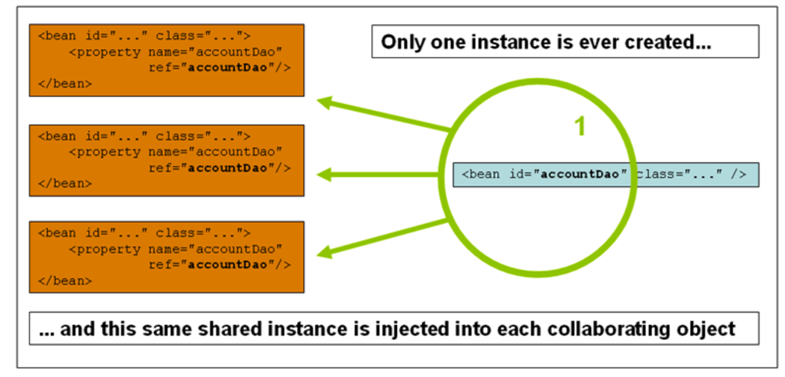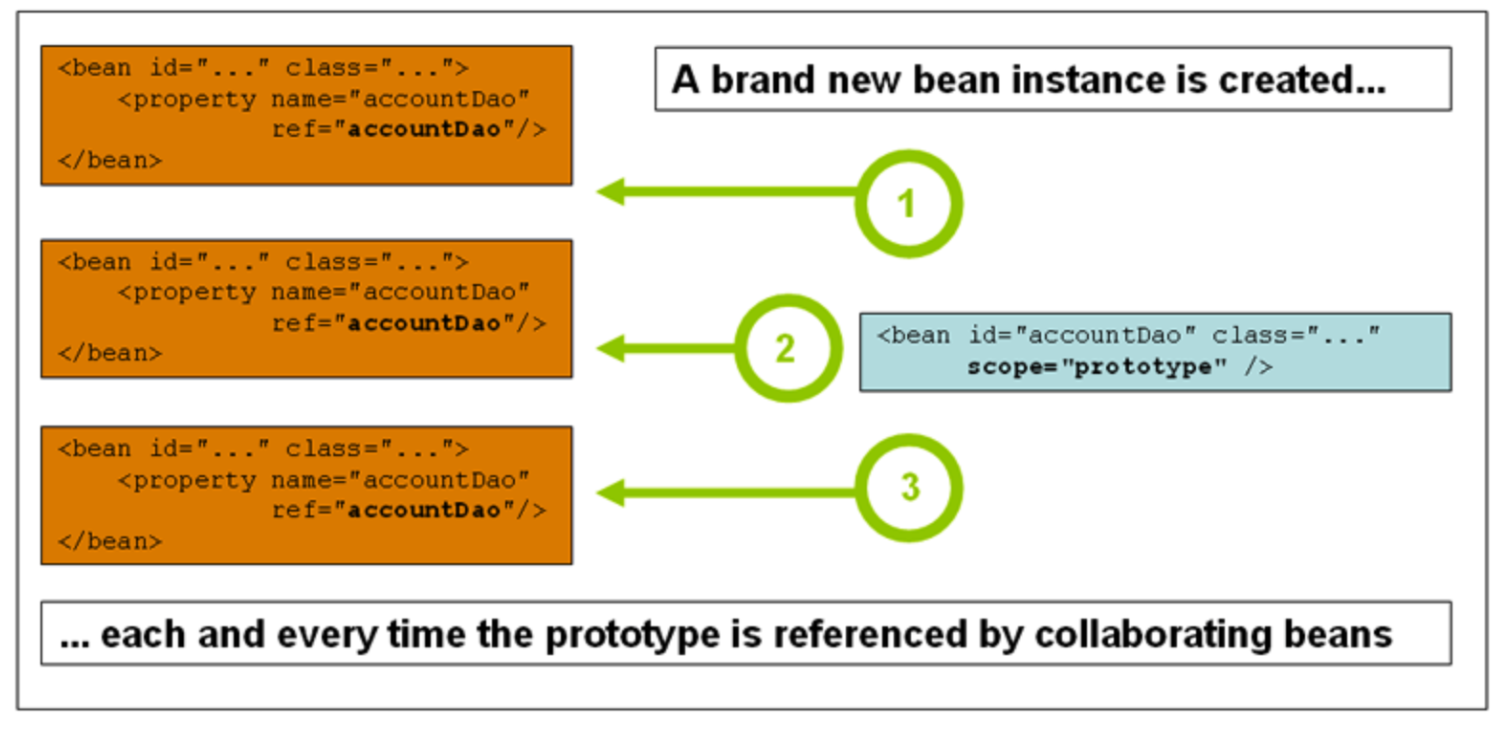标签:const sys pen rgs retention tee throws mave etc
随着 SpringBoot 的流行,基于注解式开发的热潮逐渐覆盖了基于 XML 纯配置的开发,而作为 Spring 中最核心的 bean 当然也能够使用注解的方式进行表示。所以本篇就来详细的讨论一下作为 Spring 中的 Bean 到底都有哪些用法。
Spring 的 @Bean 注解用于告诉方法,产生一个 Bean 对象,然后这个 Bean 对象交给 Spring 管理。产生这个 Bean 对象的方法 Spring 只会调用一次,随后这个 Spring 将会将这个 Bean 对象放在自己的 IOC 容器中。
SpringIOC 容器管理一个或者多个 bean,这些 bean 都需要在 @Configuration 注解下进行创建,在一个方法上使用 @Bean 注解就表明这个方法需要交给 Spring 进行管理。
快速搭建一个 maven 项目并配置好所需要的 Spring 依赖
<dependency>
<groupId>org.springframework</groupId>
<artifactId>spring-context</artifactId>
<version>4.3.13.RELEASE</version>
</dependency>
<dependency>
<groupId>org.springframework</groupId>
<artifactId>spring-beans</artifactId>
<version>4.3.13.RELEASE</version>
</dependency>
<dependency>
<groupId>org.springframework</groupId>
<artifactId>spring-core</artifactId>
<version>4.3.13.RELEASE</version>
</dependency>
<dependency>
<groupId>org.springframework</groupId>
<artifactId>spring-web</artifactId>
<version>4.3.13.RELEASE</version>
</dependency>
在 src 根目录下创建一个AppConfig的配置类,这个配置类也就是管理一个或多个 bean 的配置类,并在其内部声明一个 myBean 的 bean,并创建其对应的实体类
@Configuration
public class AppConfig {
// 使用@Bean 注解表明myBean需要交给Spring进行管理
// 未指定bean 的名称,默认采用的是 "方法名" + "首字母小写"的配置方式
@Bean
public MyBean myBean(){
return new MyBean();
}
}
public class MyBean {
public MyBean(){
System.out.println("MyBean Initializing");
}
}
在对应的 test 文件夹下创建一个测试类SpringBeanApplicationTests,测试上述代码的正确性
public class SpringBeanApplicationTests {
public static void main(String[] args) {
ApplicationContext context = new AnnotationConfigApplicationContext(AppConfig.class);
context.getBean("myBean");
}
}
输出 : MyBean Initializing
随着 SpringBoot 的流行,我们现在更多采用基于注解式的配置从而替换掉了基于 XML 的配置,所以本篇文章我们主要探讨基于注解的 @Bean 以及和其他注解的使用。
在简单介绍了一下如何声明一个 Bean 组件,并将其交给 Spring 进行管理之后,下面我们来介绍一下 Spring 的基本构成
@Target({ElementType.METHOD, ElementType.ANNOTATION_TYPE})
@Retention(RetentionPolicy.RUNTIME)
@Documented
public @interface Bean {
@AliasFor("name")
String[] value() default {};
@AliasFor("value")
String[] name() default {};
Autowire autowire() default Autowire.NO;
String initMethod() default "";
String destroyMethod() default AbstractBeanDefinition.INFER_METHOD;
}
@Bean 不仅可以作用在方法上,也可以作用在注解类型上,在运行时提供注册。
value: name 属性的别名,在不需要其他属性时使用,也就是说 value 就是默认值
name: 此 bean 的名称,或多个名称,主要的 bean 的名称加别名。如果未指定,则 bean 的名称是带注解方法的名称。如果指定了,方法的名称就会忽略,如果没有其他属性声明的话,bean 的名称和别名可能通过 value 属性配置
autowire : 此注解的方法表示自动装配的类型,返回一个Autowire类型的枚举,我们来看一下Autowire枚举类型的概念
// 枚举确定自动装配状态:即,bean是否应该使用setter注入由Spring容器自动注入其依赖项。
// 这是Spring DI的核心概念
public enum Autowire {
// 常量,表示根本没有自动装配。
NO(AutowireCapableBeanFactory.AUTOWIRE_NO),
// 常量,通过名称进行自动装配
BY_NAME(AutowireCapableBeanFactory.AUTOWIRE_BY_NAME),
// 常量,通过类型进行自动装配
BY_TYPE(AutowireCapableBeanFactory.AUTOWIRE_BY_TYPE);
private final int value;
Autowire(int value) {
this.value = value;
}
public int value() {
return this.value;
}
public boolean isAutowire() {
return (this == BY_NAME || this == BY_TYPE);
}
}
autowire 的默认值为No,默认表示不通过自动装配。
initMethod: 这个可选择的方法在 bean 实例化的时候调用,InitializationBean接口允许 bean 在合适的时机通过设置注解的初始化属性从而调用初始化方法,InitializationBean 接口有一个定义好的初始化方法
void afterPropertiesSet() throws Exception;
Spring 不推荐使用 InitializationBean 来调用其初始化方法,因为它不必要地将代码耦合到 Spring。Spring 推荐使用
@PostConstruct注解或者为 POJO 类指定其初始化方法这两种方式来完成初始化。
不推荐使用:
public class InitBean implements InitializingBean {
public void afterPropertiesSet() {}
}
destroyMethod: 方法的可选择名称在调用 bean 示例在关闭上下文的时候,例如 JDBC 的 close() 方法,或者 SqlSession 的 close() 方法。DisposableBean 接口的实现允许在 bean 销毁的时候进行回调调用,DisposableBean 接口之后一个单个的方法
void destroy() throws Exception;
Spring 不推荐使用 DisposableBean 的方式来初始化其方法,因为它会将不必要的代码耦合到 Spring。作为替代性的建议,Spring 推荐使用
@PreDestory注解或者为@Bean注解提供 destroyMethod 属性,
不推荐使用:
public class DestroyBean {
public void cleanup() {}
}
推荐使用:
public class MyBean {
public MyBean(){
System.out.println("MyBean Initializing");
}
public void init(){
System.out.println("Bean 初始化方法被调用");
}
public void destroy(){
System.out.println("Bean 销毁方法被调用");
}
}
@Configuration
public class AppConfig {
// @Bean
@Bean(initMethod = "init", destroyMethod = "destroy")
public MyBean myBean(){
return new MyBean();
}
}
修改一下测试类,测试其初始化方法和销毁方法在何时会被调用
public class SpringBeanApplicationTests {
public static void main(String[] args) {
// ------------------------------ 测试一 ------------------------------
ApplicationContext context = new AnnotationConfigApplicationContext(AppConfig.class);
// context.getBean("myBean");
// 变体
context.getBean("myBean");
((AnnotationConfigApplicationContext) context).destroy();
// ((AnnotationConfigApplicationContext) context).close();
}
}
初始化方法在得到 Bean 的实例的时候就会被调用,销毁方法在容器销毁或者容器关闭的时候会被调用。
在上面的一个小节中我们了解到了 @Bean 注解的几个属性,但是对于 @Bean 注解的功能来讲这有点太看不起 bean 了,@Bean 另外一个重要的功能是能够和其他注解产生化学反应,如果你还不了解这些注解的话,那么请继续往下读,你会有收获的
这一节我们主要探讨@profile,@scope,@lazy,@depends-on @primary等注解
@Profile 的作用是把一些 meta-data 进行分类,分成 Active 和 InActive 这两种状态,然后你可以选择在 active 和在 Inactive 这两种状态下配置 bean,在 Inactive 状态通常的注解有一个!操作符,通常写为:@Profile("!p"), 这里的 p 是 Profile 的名字。
三种设置方式:
可以通过 ConfigurableEnvironment.setActiveProfiles() 以编程的方式激活
可以通过 AbstractEnvironment.ACTIVE_PROFILES_PROPERTY_NAME (spring.profiles.active) 属性设置为
JVM 属性
作为环境变量,或作为 web.xml 应用程序的 Servlet 上下文参数。也可以通过 @ActiveProfiles 注解在集成测试中以声明方式激活配置文件。
作用域
注意:
? 如果一个配置类使用了 Profile 标签或者 @Profile 作用在任何类中都必须进行启用才会生效,如果 @Profile({"p1","!p2"}) 标识两个属性,那么 p1 是启用状态 而 p2 是非启用状态的。
现有一个 POJO 类为 Subject 学科类,里面有两个属性,一个是 like(理科) 属性,一个是 wenke(文科) 属性,分别有两个配置类,一个是AppConfigWithActiveProfile ,一个是AppConfigWithInactiveProfile,当系统环境是 "like" 的时候就注册 AppConfigWithActiveProfile ,如果是 "wenke",就注册 AppConfigWithInactiveProfile,来看一下这个需求如何实现
Subject.java
// 学科
public class Subject {
// 理科
private String like;
// 文科
private String wenke;
get and set ...
@Override
public String toString() {
return "Subject{" +
"like=‘" + like + ‘\‘‘ +
", wenke=‘" + wenke + ‘\‘‘ +
‘}‘;
}
}
AppConfigWithActiveProfile.java 注册 Profile 为 like 的时候
@Profile("like")
@Configuration
public class AppConfigWithActiveProfile {
@Bean
public Subject subject(){
Subject subject = new Subject();
subject.setLike("物理");
return subject;
}
}
AppConfigWithInactiveProfile.java 注册 Profile 为 wenke 的时候
@Profile("wenke")
@Configuration
public class AppConfigWithInactiveProfile {
@Bean
public Subject subject(){
Subject subject = new Subject();
subject.setWenke("历史");
return subject;
}
}
修改一下对应的测试类,设置系统环境,当 Profile 为 like 和 wenke 的时候分别注册各自对应的属性
// ------------------------------ 测试 profile ------------------------------
AnnotationConfigApplicationContext context = new AnnotationConfigApplicationContext();
// 激活 like 的profile
context.getEnvironment().setActiveProfiles("like");
context.register(AppConfigWithActiveProfile.class,AppConfigWithInactiveProfile.class);
context.refresh();
Subject subject = (Subject) context.getBean("subject");
System.out.println("subject = " + subject);
把 context.getEnvironment().setActiveProfiles("wenke") 设置为 wenke,观察其对应的输出内容发生了变化,这就是 @Profile 的作用,有一层可选择性注册的意味。
在 Spring 中对于 bean 的默认处理都是单例的,我们通过上下文容器. getBean 方法拿到 bean 容器,并对其进行实例化,这个实例化的过程其实只进行一次,即多次 getBean 获取的对象都是同一个对象,也就相当于这个 bean 的实例在 IOC 容器中是 public 的,对于所有的 bean 请求来讲都可以共享此 bean。

那么假如我不想把这个 bean 被所有的请求共享或者说每次调用我都想让它生成一个 bean 实例该怎么处理呢?
多例 Bean
bean 的非单例原型范围会使每次发出对该特定 bean 的请求时都创建新的 bean 实例,也就是说,bean 被注入另一个 bean,或者通过对容器的 getBean() 方法调用来请求它,可以用如下图来表示:

通过一个示例来说明 bean 的多个实例
新建一个AppConfigWithAliasAndScope配置类,用来定义多例的 bean,
@Configuration
public class AppConfigWithAliasAndScope {
/**
* 为myBean起两个名字,b1 和 b2
* @Scope 默认为 singleton,但是可以指定其作用域
* prototype 是多例的,即每一次调用都会生成一个新的实例。
*/
@Bean({"b1","b2"})
@Scope("prototype")
public MyBean myBean(){
return new MyBean();
}
}
测试一下多例的情况:
// ------------------------------ 测试scope ------------------------------
ApplicationContext context = new AnnotationConfigApplicationContext(AppConfigWithAliasAndScope.class);
MyBean myBean = (MyBean) context.getBean("b1");
MyBean myBean2 = (MyBean) context.getBean("b2");
System.out.println(myBean);
System.out.println(myBean2);
其他情况
除了多例的情况下,Spring 还为我们定义了其他情况:
| Scope | Descriptionn |
|---|---|
| singleton | 默认单例的 bean 定义信息,对于每个 IOC 容器来说都是单例对象 |
| prototype | bean 对象的定义为任意数量的对象实例 |
| request | bean 对象的定义为一次 HTTP 请求的生命周期,也就是说,每个 HTTP 请求都有自己的 bean 实例,它是在单个 bean 定义的后面创建的。仅仅在 web-aware 的上下文中有效 |
| session | bean 对象的定义为一次 HTTP 会话的生命周期。仅仅在 web-aware 的上下文中有效 |
| application | bean 对象的定义范围在 ServletContext 生命周期内。仅仅在 web-aware 的上下文中有效 |
| websocket | bean 对象的定义为 WebSocket 的生命周期内。仅仅在 web-aware 的上下文中有效 |
singleton 和 prototype 一般都用在普通的 Java 项目中,而 request、session、application、websocket 都用于 web 应用中。
request、session、application、websocket 的作用范围
你可以体会到 request、session、application、websocket 的作用范围在当你使用 web-aware 的 ApplicationContext 应用程序上下文的时候,比如XmlWebApplicationContext的实现类。如果你使用了像是ClassPathXmlApplicationContext的上下文环境时,就会抛出IllegalStateException因为 Spring 不认识这个作用范围。
@Lazy : 表明一个 bean 是否延迟加载,可以作用在方法上,表示这个方法被延迟加载;可以作用在 @Component (或者由 @Component 作为原注解) 注释的类上,表明这个类中所有的 bean 都被延迟加载。如果没有 @Lazy 注释,或者 @Lazy 被设置为 false,那么该 bean 就会急切渴望被加载;除了上面两种作用域,@Lazy 还可以作用在 @Autowired 和 @Inject 注释的属性上,在这种情况下,它将为该字段创建一个惰性代理,作为使用 ObjectFactory 或 Provider 的默认方法。下面来演示一下:
@Lazy
@Configuration
@ComponentScan(basePackages = "com.spring.configuration.pojo")
public class AppConfigWithLazy {
@Bean
public MyBean myBean(){
System.out.println("myBean Initialized");
return new MyBean();
}
@Bean
public MyBean IfLazyInit(){
System.out.println("initialized");
return new MyBean();
}
}
public class SpringConfigurationApplication {
public static void main(String[] args) {
AnnotationConfigApplicationContext context = new AnnotationConfigApplicationContext(AppConfigWithLazy.class);
// 获取启动过程中的bean 定义的名称
for(String str : context.getBeanDefinitionNames()){
System.out.println("str = " + str);
}
}
}
输出你会发现没有关于 bean 的定义信息,但是当把 @Lazy 注释拿掉,你会发现输出了关于 bean 的初始化信息
指当前 bean 所依赖的 bean。任何指定的 bean 都能保证在此 bean 创建之前由 IOC 容器创建。在 bean 没有通过属性或构造函数参数显式依赖于另一个 bean 的情况下很少使用,可能直接使用在任何直接或者间接使用 Component 或者 Bean 注解表明的类上。来看一下具体的用法
新建三个 Bean,分别是 FirstBean、SecondBean、ThirdBean 三个普通的 bean,新建AppConfigWithDependsOn并配置它们之间的依赖关系
public class FirstBean {
@Autowired
private SecondBean secondBean;
@Autowired
private ThirdBean thirdBean;
public FirstBean() {
System.out.println("FirstBean Initialized via Constuctor");
}
}
public class SecondBean {
public SecondBean() {
System.out.println("SecondBean Initialized via Constuctor");
}
}
public class ThirdBean {
public ThirdBean() {
System.out.println("ThirdBean Initialized via Constuctor");
}
}
@Configuration
public class AppConfigWithDependsOn {
@Bean("firstBean")
@DependsOn(value = {
"secondBean",
"thirdBean"
})
public FirstBean firstBean() {
return new FirstBean();
}
@Bean("secondBean")
public SecondBean secondBean() {
return new SecondBean();
}
@Bean("thirdBean")
public ThirdBean thirdBean() {
return new ThirdBean();
}
}
使用测试类进行测试,如下
// ------------------------------ 测试 DependsOn ------------------------------
AnnotationConfigApplicationContext context = new AnnotationConfigApplicationContext(AppConfigWithDependsOn.class);
context.getBean(FirstBean.class);
context.close();
输出 :
SecondBean Initialized via Constuctor
ThirdBean Initialized via Constuctor
FirstBean Initialized via Constuctor
由于 firstBean 的创建过程首先需要依赖secondBean 和 thirdBean的创建,所以 secondBean 首先被加载其次是 thirdBean 最后是 firstBean。
如果把 @DependsOn 注解加在AppConfigWithDependsOn 类上则它们的初始化顺序就会变为 firstBean、secondBean、thirdBean
指示当多个候选者有资格自动装配依赖项时,应优先考虑 bean。此注解在语义上就等同于在 Spring XML 中定义的 bean 元素的 primary 属性。注意: 除非使用 component-scanning 进行组件扫描,否则在类级别上使用 @Primary 不会有作用。如果 @Primary 注解定义在 XML 中,那么 @Primary 的注解元注解就会忽略,相反使用
@Primary 的两种使用方式
通过一则示例来演示一下:
新建一个AppConfigWithPrimary类,在方法级别上定义 @Primary 注解
@Configuration
public class AppConfigWithPrimary {
@Bean
public MyBean myBeanOne(){
return new MyBean();
}
@Bean
@Primary
public MyBean myBeanTwo(){
return new MyBean();
}
}
上面代码定义了两个 bean ,其中 myBeanTwo 由 @Primary 进行标注,表示它首先会进行注册,使用测试类进行测试
// ------------------------------ 测试 Primary ------------------------------
AnnotationConfigApplicationContext context = new AnnotationConfigApplicationContext(AppConfigWithPrimary.class);
MyBean bean = context.getBean(MyBean.class);
System.out.println(bean);
你可以尝试放开 @Primary ,使用测试类测试的话会发现出现报错信息,因为你尝试获取的是 MyBean.class, 而我们代码中定义了两个 MyBean 的类型,所以需要 @Primary 注解表明哪一个 bean 需要优先被获取。
标签:const sys pen rgs retention tee throws mave etc
原文地址:https://www.cnblogs.com/hanlk/p/14532272.html